Before we show you what’s new,
HERE’S A FREE GIFT FOR YOU
57-MINUTE
PSAP TRAINING COURSe
It’s Equature’s gift to you to improve PSAP operations today.
Train your entire response team every year with this insightful program.
RESPONDER SAFETY: NO SUCH THING AS ROUTINE
There were 164 line of duty deaths in 2018. There are no routine calls. Each first responder call is unique and complacency only puts lives at risk. Reinforce these key concepts:
- When to conduct status checks
- How to ensure radio security before giving wanted information
- Why broadcast stolen or DWI in jurisdiction
- How to lower domestic violence risks
Learn what precautions to take to keep first responders safe.
57-MINUTE
PSAP TRAINING
COURSe
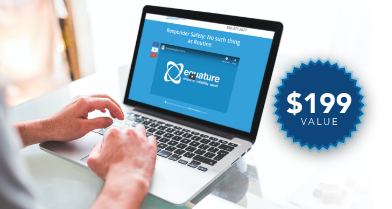
It’s Equature’s gift to you to improve
PSAP operations today.
Train your entire response team
every year with this insightful program.
RESPONDER SAFETY:
NO SUCH THING AS ROUTINE
There were 164 line of duty deaths in 2018. There are no routine calls. Each first responder call is unique and complacency only puts lives at risk. Reinforce these key concepts:
- When to conduct status checks
- How to ensure radio security before giving
wanted information - Why broadcast stolen or DWI in jurisdiction
- How to lower domestic violence risks
Learn what precautions to take
to keep first responders safe.
Did you know these PSAP stats?
- 240 million 911 calls are placed each year.
- 70-80% of 911 calls are placed via cell phone and location information from carriers varies wildly.
- The chances of 911 dispatch getting a quick fix location ranges from 10-95%.
- Every year in the United States, 10,120 lives are lost due to inadequate location accuracy in field response.
- The average U.S. 911 response time takes 10-15 minutes to reach a person in need.
- Of 6,100+ PSAPS nationwide, only little more than 21% can accurately interpret a caller’s location.
- The FCC has mandated that by 2021 carriers must improve location accuracy within 50 meters for 80% of cellular 911 calls.
- That’s still only 4 out of 5!!
Did you know
these PSAP stats?
- 240 million 911 calls are placed each year.
- 70-80% of 911 calls are placed via cell phone and location information from carriers varies wildly.
- The chances of 911 dispatch getting a quick fix location ranges from 10-95%.
- Every year in the United States, 10,120 lives are lost due to inadequate location accuracy in field response.
- The average U.S. 911 response time takes 10-15 minutes to reach a person in need.
- Of 6,100+ PSAPS nationwide, only little more than 21% can accurately interpret a caller’s location.
- The FCC has mandated that by 2021 carriers must improve location accuracy within 50 meters for 80% of cellular 911 calls.
- That’s still only 4 out of 5!!
Sometimes callers can’t
give their location
- Accent/language barrier
- Stroke
- Physical injury
- Asthma attack
- Pain
- Threat of violence
- Panic
- Lost
- Kidnapped
- Immobilized with fear
- Under the influence
Sometimes callers
can’t give
their location

- Accent/language barrier
- Stroke
- Physical injury
- Asthma attack
- Pain
- Threat of violence
- Panic
- Lost
- Kidnapped
- Immobilized with fear
- Under the influence
Why can uber find you when emergency help cannot?
Apps like Facebook can pinpoint a location because they are connected directly to the GPS unit inside the phone. The 911 system relies on getting that information through a relay process via cell phone providers which are unreliable.
Among the worst places: Silicon Valley. In December 2012, precise location was shared in 10%-37% of the area’s emergency calls, depending on the wireless carrier.
“It is now easier than ever for victims to reach 911, but harder than ever for responders to reach them,” said David Shoar,
the sheriff in St. John’s County, Fla., writing to the FCC.
Apps like Facebook can pinpoint a location because they are connected directly to the GPS unit inside the phone. The 911
system relies on getting that information through a relay process via cell phone providers which are unreliable.
Among the worst places: Silicon Valley. In December 2012, precise location was shared in 10%-37% of the area’s emergency calls, depending on the wireless carrier.
“It is now easier than ever for victims to reach 911, but harder than ever for responders to reach them,” said David Shoar,
the sheriff in St. John’s County, Fla., writing to the FCC.
Want to learn more about becoming a 21st century tech-enabled psap?
Yes, contact meTHE HISTORY OF 911
March 13, 1964, at around 2:40 in the morning, 28-year-old Kitty Genovese was attacked with a knife just a block from her apartment and died in her stairwell. Police records showed 38 people admitted to hearing her cries for help, but not a single witness called to report the incident. The central 911 system was the result of press around the case.
The 911 system was designed for landline telephones, transmitting call and location (ANI) instantly over a hard-wired connection.
It was clear by the early 1990s that the need for 911 advanced, location-based technology was necessary due to the increasing use of cellphones.
1992, the FCC created a committee to figure out a solution. But the committee members failed to predict just how ubiquitous cellphones would become. The early cellphone-tracking methods—most of which are still in use today — focused on locating people outside, with the assumption that indoor calls would come from a landline.
Today’s cellphone system does not automatically send location data when you dial 911. After the call comes in, the dispatcher’s computer transmits a digital request to the cellphone network seeking the phone’s location. The data exchange can take seconds or even minutes. Sometimes, it doesn’t return a location at all.
Despite efforts to improve accuracy by 2021, most PSAPS are still using infrastructure created in the 1960s for landlines. Automatic Location Information (ALI) only delivered civic addresses until the advent of mobile phones, which have no fixed address. For mobile phones, the geographic location of the phone is delivered in the form of Latitude and Longitude, or Lat/Long coordinates. Because cell tower triangulation is typically used to determine these coordinates, the location is not very accurate. Indeed, the initial location delivered for a call is often only accurate within several square miles.
GET ACCESS TO A 57-MINUTE PSAP TRAINING COURSe
It’s Equature’s gift to you to improve PSAP operations today.
Train your entire response team every year with this insightful program.
RESPONDER SAFETY: NO SUCH THING AS ROUTINE
There were 164 line of duty deaths in 2018. There are no routine calls. Each first responder call is unique and complacency only puts lives at risk. Reinforce these key concepts:
- When to conduct status checks
- How to ensure radio security before giving wanted information
- Why broadcast stolen or DWI in jurisdiction
- How to lower domestic violence risks
Learn what precautions to take to keep first responders safe.
57-MINUTE
PSAP TRAINING
COURSe

It’s Equature’s gift to you to improve
PSAP operations today.
Train your entire response team
every year with this insightful program.
RESPONDER SAFETY:
NO SUCH THING AS ROUTINE
There were 164 line of duty deaths in 2018. There are no routine calls. Each first responder call is unique and complacency only puts lives at risk. Reinforce these key concepts:
- When to conduct status checks
- How to ensure radio security before giving
wanted information - Why broadcast stolen or DWI in jurisdiction
- How to lower domestic violence risks
Learn what precautions to take
to keep first responders safe.
Smartphones
can do all of this…
- Exact location (GPS, cell tower, WiFi, etc.)
- Connect to any medium: LTE/4G, WiFi, PSTN
- Text
- Voice
- Real-time medical information
- Camera
- Video conference
- Give directions
- Alert emergency contacts
But most PSAPS
can only do this…
- Estimated location (cell tower, sometimes GPS)
- Connect to PTSN
- Text (less than 25% of PSAPS)
- Voice
- Real-time medical information
- Camera
- Video conference
- Give directions
- Alert emergency contacts
What about E911?
Short for Enhanced 911, a location technology advanced by the FCC that will enable mobile, or cellular, phones to process 911 emergency calls and enable emergency services to locate the geographic position of the caller. The location must be accurate within 50-300 meters (164-984 feet).
But new technology by Equature InSight allows dispatchers to locate the caller’s exact location within 20 feet.
What about E911?
Short for Enhanced 911, a location
technology advanced by the FCC that will
enable mobile, or cellular,
phones to process 911 emergency calls and
enable emergency services to locate the
geographic position
of the caller. The location must be accurate
within 50-300 meters (164-984 feet).
But new technology by Equature
InSight allows dispatchers to
locate the caller’s exact location
within 20 feet.
EVOLUTION

Most PSAPs on North America are still using the legacy ALI system, or are in a state of transition to NG9-1-1 thatr doesn't yet provide location to the PSAP in SIP call INVITE. It's a common misconception that if you have NG911 equipment, then have NG911 with better location accuracy and that's simply not the case.
GET ACCESS TO A 57-MINUTE PSAP TRAINING COURSe
It’s Equature’s gift to you to improve PSAP operations today.
Train your entire response team every year with this insightful program.
RESPONDER SAFETY: NO SUCH THING AS ROUTINE
There were 164 line of duty deaths in 2018. There are no routine calls. Each first responder call is unique and complacency only puts lives at risk. Reinforce these key concepts:
- When to conduct status checks
- How to ensure radio security before giving wanted information
- Why broadcast stolen or DWI in jurisdiction
- How to lower domestic violence risks
Learn what precautions to take to keep first responders safe.
57-MINUTE
PSAP TRAINING
COURSe

It’s Equature’s gift to you to improve
PSAP operations today.
Train your entire response team
every year with this insightful program.
RESPONDER SAFETY:
NO SUCH THING AS ROUTINE
There were 164 line of duty deaths in 2018.
There are no routine calls. Each first responder
call is unique and complacency only puts lives
at risk. Reinforce these key concepts:
- When to conduct status checks
- How to ensure radio security before giving
wanted information - Why broadcast stolen or DWI in jurisdiction
- How to lower domestic violence risks
Learn what precautions to take
to keep first responders safe.
Why are video calls so much better than audio?
Because 55% of the message is non-verbal
Mehrabian’s 7-38-55 Rule illustrates why video helps PSAPS and field responders, construct accurate scenarios:
Why are video calls so much better
than audio?
Because 55% of the
message is non-verbal
Mehrabian’s 7-38-55 Rule
illustrates why video helps PSAPS
and field responders, construct
accurate scenarios:
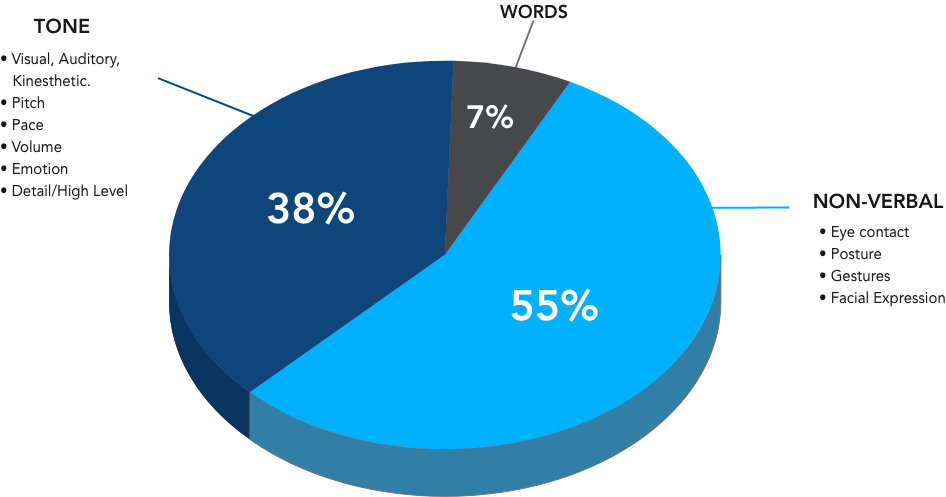
Channel effectiveness: how much of the message
is conveyed in each communication element?
HINT: only 7% of communication is imparted with words alone.
Channel effectiveness: how much of the message
is conveyed in each communication element?
HINT: only 7% of communication
is imparted with words alone.
How does Connect work?
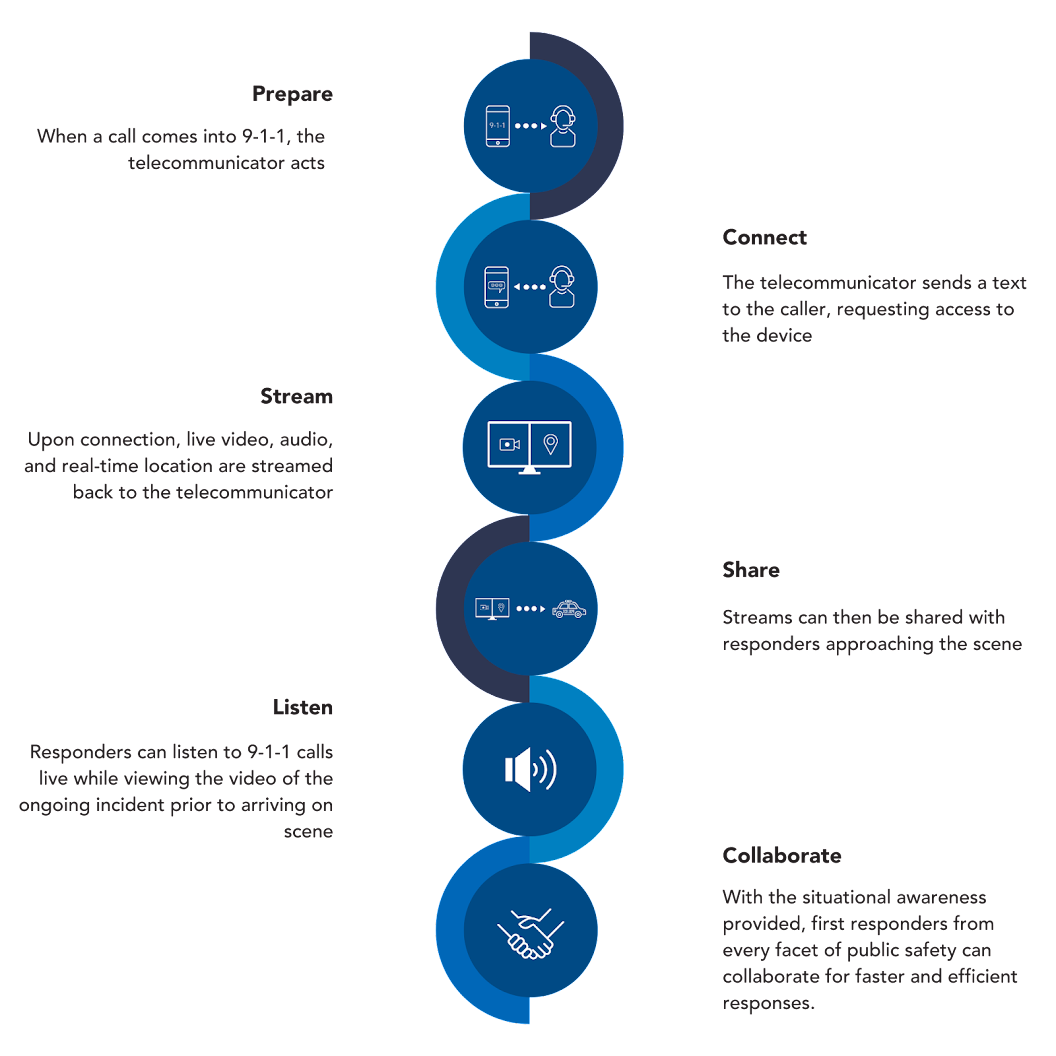
NG911 reduces response time. We can do better!
Which countries have the lowest response times?
NG911
reduces response
time. We can
do better!
Which countries have the
lowest response times?

U.S. & Germany - 10-15 min.
Hong Kong - 12 min.
China (urban) - 5-10 min.
Canada - 9 min.
U.K. - 8-19 min.
Taiwan - 4.1-4.9 min.
U.S. & Germany - 10-15 min.
Hong Kong - 12 min.
China (urban) - 5-10 min.
Canada - 9 min.
U.K. - 8-19 min.
Taiwan - 4.1-4.9 min.
India has the largest and most effective
emergency response system in the world.
India has the
largest and most
effective
emergency
response system
in the world.

They have done this through a centralized, call-in system that receives 150,000 calls and responds to nearly 25,000 emergencies each day at a cost of $0.25 USD per person per year.
The service is free to the user and costs the provider less than $15 USD per emergency— less than 1% of the cost in the U.S.
HERE’S HOW EQUATURE INSIGHT
COULD HAVE SAVED THESE LIVES

In 2010 in Cortez, CO, for two minutes, Carol Ouellet’s lungs slowly filled with blood as she tried unsuccessfully to give the 911 dispatcher information. Because the cellphone didn’t include location data, it took the dispatcher two hours to locate Ouellet. By the time responders found her, she was dead. With Equature InSight, the dispatcher would have pinpointed the caller’s advanced location within 6 meters (20 feet).

In 2010 in Cortez, CO, for two minutes, Carol Ouellet’s lungs slowly filled with blood as she tried unsuccessfully to give the 911 dispatcher information. Because the cellphone didn’t include location data, it took the dispatcher two hours to locate Ouellet. By the time responders found her, she was dead. With Equature InSight, the dispatcher would have pinpointed the caller’s advanced location within 6 meters (20 feet).

In 2006, after his mother collapsed, five-year-old Robert Turner called 911. The dispatcher believed it was a prank call, told him help was on the way, and hung up. After three hours and his mother still unconscious, he called 911 again. This time, a different dispatcher told him that playing games would get him in trouble. Robert got scared and hung up. His mother died. With Equature InSight, the capability to live stream video from the caller’s smartphone would have allowed the dispatcher to understand the scene and make informed decisions.
In 2006, after his mother collapsed, five-year-old Robert Turner called 911. The dispatcher believed it was a prank call, told him help was on the way, and hung up. After three hours and his mother still unconscious, he called 911 again. This time, a different dispatcher told him that playing games would get him in trouble. Robert got scared and hung up. His mother died. With Equature InSight, the capability to live stream video from the caller’s smartphone would have allowed the dispatcher to understand the scene and make informed decisions.

Save lives, gain and keep community trust,
better prepare first responders, and prevent lawsuits.

2015 in Milton, GA, Shannell Anderson took a right turn on what she thought was Batesville Road and ended up in a pond.Unable to open the car doors, she called 911 and gave the dispatcher her exact location, but she was talking to the wrong dispatch operation as her phone had connected through the wrong tower to nearby Fulton County. Fire fighters were delayed as emergency teams figured out what happened and while eventually found, Shannell never recovered. With Equature InSight, the dispatcher would have pinpointed the caller’s advanced location within 6 meters (20 feet).
In 2018, Kyle Plush was pinned under the third-row folding seat of his minivan in the high school parking lot while trying to retrieve his tennis equipment. He was able to call 911 for help and give the parking lot location. Law enforcement responded and a deputy searched two of many parking lots near the school for 11 minutes and closed the case. Later that night Kyle’s father used a phone locating app to pinpoint Kyle’s location for police who found Kyle asphyxiated from chest compression. With Equature InSight, the dispatcher would have pinpointed the caller’s advanced location within 6 meters (20 feet).


In 2018, Kyle Plush was pinned under the third-row folding seat of his minivan in the high school parking lot while trying to retrieve his tennis equipment. He was able to call 911 for help and give the parking lot location. Law enforcement responded and a deputy searched two of many parking lots near the school for 11 minutes and closed the case. Later that night Kyle’s father used a phone locating app to pinpoint Kyle’s location for police who found Kyle asphyxiated from chest compression. With Equature InSight, the dispatcher would have pinpointed the caller’s advanced location within 6 meters (20 feet).
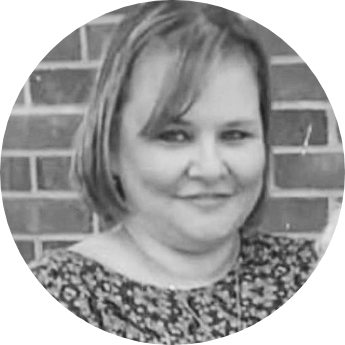
In Fort Smith AR, in 2019 Debra Stevens was working her normal newspaper delivery route in Fort Smith, when rising flood waters began to overtake her SUV. Unable to swim she called 911 for a 22-minute call that ended in her drowning death as dispatchers and fire fighters struggled to work through confusion about her location. With Equature InSight, the dispatcher would have pinpointed the caller’s advanced location within 6 meters (20 feet).
Why should PSAPs care about improved response times and fewer mistakes?
Why should PSAPs
care about improved
response
times and fewer
mistakes?
- Just want to do a better job
- Avoid liability and litigation
- Get professional recognition for your center as your statistics improve
- Eliminate high-profile, bad PR on the news and in the community

Bad press yields worse results
“A lot of people are innately distrustful. And if they’ve seen in the media that dispatchers have done terrible things, like refusing to send help or not answering the phone because they’re asleep, there’s a little suspicion that when their emergency occurs, things are going to go wrong.
So, when they call in, they’re anxious because they have an emergency, or at least a situation that’s terribly disturbing, and they’ll assess whether they’ve reached a helper or hinderer, a professional or an amateur, a leader or someone who’s just as confused as they are. If they think they’ve reached any of the latter, you can imagine what happens to their emotional content: it starts to go up.”
Jeff Clawson MD, owner of Medical Priority Consultants, Inc., Salt Lake City, UT, (dubbed the “father” of EMS dispatching for his pioneering work)
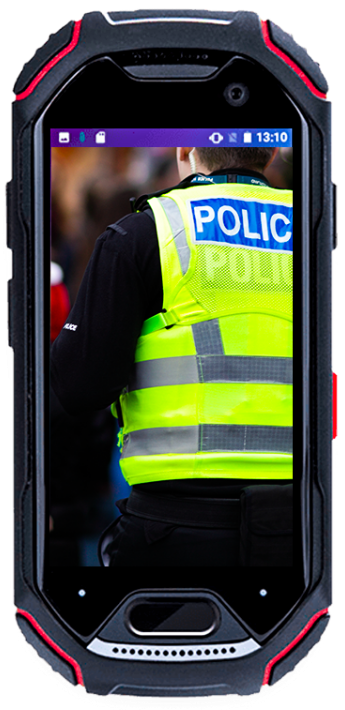
TECHNOLOGY IS THE GREAT EQUALIZER
TurboTax replaced hundred of thousands of accountants. Print newspapers were rendered nearly obsolete by online publications. Amazon forced brick-and-mortar booksellers out of business.
Creative destruction is now disrupting even the dinosaur industries. Virtual doctor visits, blockchain currency, and autonomous vehicles are on the precipice.
911 technology has hardly changed since its emergence 50 years ago, meanwhile, Google Maps knows exactly where you are. Even with the FCC mandate to improve 911 technology by 2021, it’s still not enough. PSAPS will only be able to find callers 80% of the time, leaving 1 out of every 5 lost to chance.
It’s time for PSAPS to come into the 21st century and take the lead in advanced response and safety.
Get ahead of the curve and enjoy all the benefits of being on the forefront with advanced technology now. (Or play catch-up later.)
TECHNOLOGY IS THE
GREAT EQUALIZER
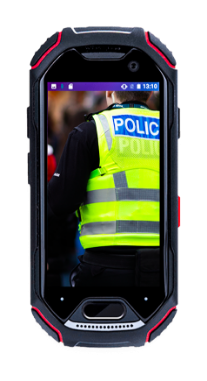
TurboTax replaced hundred of thousands of accountants. Print newspapers were rendered nearly obsolete by online publications. Amazon forced brick-and-mortar booksellers out of business.
Creative destruction is now disrupting even the dinosaur industries. Virtual doctor visits, blockchain currency, and autonomous vehicles are on the precipice.
911 technology has hardly changed since its emergence 50 years ago, meanwhile, Google Maps knows exactly where you are. Even with the FCC mandate to improve 911 technology
by
2021, it’s still not enough. PSAPS will only be able to find callers 80% of the time, leaving 1 out of every 5 lost to chance.
It’s time for PSAPS to come into the 21st century and take the lead in advanced response and safety.
Get ahead of the curve and enjoy all the benefits of being on the forefront with advanced
technology now. (Or play catch-up later.)
GET ACCESS TO A 57-MINUTE PSAP TRAINING COURSe
It’s Equature’s gift to you to improve PSAP operations today.
Train your entire response team every year with this insightful program.
RESPONDER SAFETY: NO SUCH THING AS ROUTINE
There were 164 line of duty deaths in 2018. There are no routine calls. Each first responder call is unique and complacency only puts lives at risk. Reinforce these key concepts:
- When to conduct status checks
- How to ensure radio security before giving wanted information
- Why broadcast stolen or DWI in jurisdiction
- How to lower domestic violence risks
Learn what precautions to take to keep first responders safe.
57-MINUTE
PSAP TRAINING
COURSe

It’s Equature’s gift to you to improve
PSAP operations today.
Train your entire response team
every year with this insightful program.
RESPONDER SAFETY:
NO SUCH THING AS ROUTINE
There were 164 line of duty deaths in 2018.
There are no routine calls. Each first responder
call is unique and complacency only puts lives
at risk. Reinforce these key concepts:
- When to conduct status checks
- How to ensure radio security before giving
wanted information - Why broadcast stolen or DWI in jurisdiction
- How to lower domestic violence risks
Learn what precautions to take
to keep first responders safe.
Get the Equature InSight advantage:
Get the Equature
InSight advantage:
- See what is happening before officers arrive
- Pinpoint advanced location from caller’s smartphone.
- Understand the scene with better situational awareness
- Have visual for officers BEFORE they arrive on scene
- Eliminate he said / she said mistakes
- Dispatch faster with accurate scene details.
- Provide medical advice knowing EXACTLY what is happening with visuals and not relying on he said / she said.
- Share live scene visuals with everyone at the same time for informed decisions and situational awareness.
- NEVER GO IN BLIND AGAIN!!!
DONT SETTLE, CHANGE THESE PSAP STATS WITH INSIGHT:
-Every year in the US, 10,120 lives are lost due to inadequate location accuracy in field response.
-The chances of 911 dispatch getting a quick fix location ranges from 10%-95%.
-Of 6,100+ PSAPS nationwide, only little more than 21% can accurately interpret a caller's location.
-The FCC has mandated that by 2021 carriers must improve location accuracy within 50meters for 80% of cellular 911 calss, but that's still only 4 out of 5.
WHO IS EQUATURE?
INTERNATIONAL LEADER IN INTERACTIVE PUBLIC SAFETY RESPONSE
America’s #1 most-trusted public safety software platform reducing call-for-service times while keeping our field responders safe.
We exist to provide real-time tools and interaction to help first responders respond faster and stay safe.
Our Customers
Founded in 1969, Equature® is a privately-held public safety software company that currently has over 2,000 government agencies and law enforcement police departments as customers.
top 10 most promising homeland security providers in 2017



